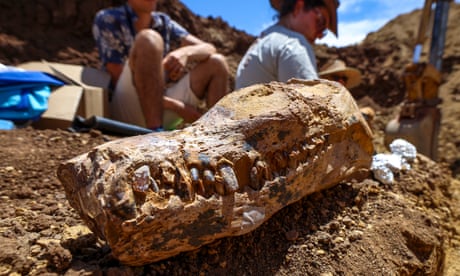- by foxnews
- 05 Apr 2025
Queensland graziers unearth 100m-year-old plesiosaur remains likened to Rosetta Stone
Queensland graziers unearth 100m-year-old plesiosaur remains likened to Rosetta Stone
- by theguardian
- 07 Dec 2022
- in news

A group of female graziers from outback Queensland who hunt fossils in their downtime have uncovered the remains of a 100m-year-old creature that palaeontologists are likening to the Rosetta Stone for its potential to unlock the discovery of several new species of prehistoric marine giant.
This was the first time that an elasmosaur skull has been found connected to its body in Australia.
The information that provides could allow palaeontologists to decipher other fossils held in museums, just as the Rosetta Stone, with its three scripts, allowed philologists to crack ancient Egyptian hieroglyphics.
The trio had already found another plesiosaur among other significant fossil finds in the weeks leading up to the moment when Cassandra Prince saw a head looking up at her from the dry earth.
Such a fossil, which has been kept under wraps until now, is globally rare, according to Dr Espen Knutsen, the senior curator of palaeontology at the Queensland Museum.
The museum already holds the skull of an elasmosaur its collection, along with several bodies. But a skull connected to a body has proved elusive.
This is largely to do with the distinctive anatomy of elasmosaur. The marine reptiles probably grew to around eight metres in length and had tiny heads atop very, very long necks.
When an elasmosaur died, its decomposing body would swell with gas that made it rise to the surface, where it would float at the mercy of tides and scavengers. A metres-long gap between body and head meant these body parts would rarely sink to the same spot once the gas dissipated.
But that work is likely to also shed light on many other prehistoric beasts that swam central Queensland during the Cretaceous period, when the now arid grasslands formed part of the supercontinent Gondwanaland and were submerged beneath a vast inland sea upon whose shores dinosaurs roamed.
While only one species can currently be deciphered from the remains already found in Australia, Knutsen is confident that many different kinds of elasmosaurs shared that prehistoric sea.
The skull and body that Prince found, however, is three-dimensionally preserved, allowing a much richer insight into the anatomy and way of life of the elasmosaur.
Scientists have wondered whether the prehistoric reptiles used their teeth to filter feed crustaceans and bivalves from the ocean floor, and their big flippers to slowly cruise along migration routes as whales do today.
Knutsen hopes Little Prince could shed light on those questions, while enabling paleontologists to describe several species from the disparate remains already held within the museum.
- by foxnews
- descember 09, 2016
Excavation near site where Jesus was crucified and buried results in ancient discovery
Proof of ancient olive trees and grapevines, consistent with a Bible verse, has been found at the Church of the Holy Sepulchre in Jerusalem, an archaeologist confirms.
read more


